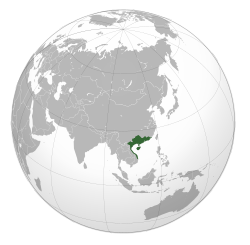Lingnan
Lingnan
Lĩnh Nam | |
|---|---|
 Maximum extent of theNanyuekingdom, roughly corresponding to the geographical region of Lingnan with the exception of Central Vietnam | |
| Modern day-location | Guangdong,Guangxi,Hainan,Hong Kong,Macau,and NorthVietnam(Tonkin) |
Lingnan(simplified Chinese:Lĩnh Nam;traditional Chinese:Lĩnh Nam;pinyin:lǐng nán;Jyutping:ling5 naam4;lit.'South of the [Nanling] Mountains';Vietnamese:Lĩnh Nam) is a geographic area referring to the lands in the south of theNanling Mountains.The region covers the modernChinesesubdivisions ofGuangdong,Guangxi,Hainan,Hong Kong&Macau[1][2]andNorthern Vietnam.
Background
[edit]The area was inhabited by theBaiyueand was the base of the ancient kingdom ofNanyue.At that time, Lingnan was considered by the ancient Chinese court to be a tropical barbarian land that had no contact with theZhongyuan,which was the cultural cradle ofChinese culture.
In the second century BCE, theHan conquest of Nanyueled to its absorption into theHan dynastyduring itssouthward expansion,and its development was boosted once theMei Passwas paved. The region was also the base of the Kingdom ofSouthern Han(917–971).[3]
Lingnan Jiedushi
[edit]LingnanJiedushior military command, were ruled by military governors during the Tang dynasty.
List of jiedushis:
- Song Jing716
- Zhen Dan 717
- Pei Zhouxian 719-722
- Li Ju 727-735
- Li Shangyin 727
- Li Chaoyin 733-735
- Song Ding 739
- Pei Dunfu 745
- Peng Guo 745-747
- Lu Huan 749-751
- Zhang Jiugao 751-753
- A Lüguang 754-756
- Helan Jinming 756
- Wei Li gian 757-758
- Zhang Wanqing 758-760
- Zhao Liangbi 760-761
- Zhang Xiu 763
- Yang Shenwei 764-767
- Xu Hao 767-768
- Li Mian768-772
- Li Chongben 772-773
- Lu Sigong 773
- Li Shu775
- Gao Yun 776-777
- Zhang Boyi 777-782
- Yuan Xiu 782-784
- Du You784-787
- Li Fu 787-792
- Xue Jue 792-795
- Wang E 795-801
- Zhao Zhi 801-802
- Xu Shen 802-806
- Zhao Chang 806-808
- Yang Yuling 808-810
- Zheng Yin810-813
- Ma Zong 813-816
- Cui Yong 817
- Kong Kui 817-820
- Cui Neng 820-823
- Zheng Quan 823-824
- Cui Zhi824-826
- Hu Zheng 826-828
- Li Xian 828-829
- Cui Hu 829-830
- Li Liang 831-833
- Cui Gong833
- Wang Maoyuan 833-835
- Li Congyi 835-836
- Lu Jun 836-840
- Cui Guicong844-845
- Lu Zhen 845-846
- Li Pin 847-848
- Li Xingxiu 848-849
- Wei Zhengguan 849-851
- Ge Ganzhong 851-854
- Wei Shu 855-858
- Yang Fa 858
- Li Sui 858
- Li Chengxun 858-859
- Xiao Fang 859-860
- Wei Zhou 861-868
- Zheng Yu 868-871
- Zheng Congdang871-874
- Wei He 874-876
- Li Tiao 877-879
- Zheng Xu 879-886
- Lü Yongzhi886
- Pei Qu 887-889
- Li Chonggui 890-895
- Chen Pei 893
- Cui Yin896
- Li Zhirou896-900
- Cui Yin900
- Xu Yanruo900-901
- Liu Yin901-911
- Pei Shu903
- Cui Yuan904
- Liu Yan 911-917
See also
[edit]References
[edit]- ^Guo, Jie; Zuo, Pengjun (2018).Lĩnh Nam văn hóa nghiên cứu.Đại học Thanh Hoa nhà xuất bản.ISBN9787302399476.
- ^Xie, Xuanjun (2015).Cách mạng Tân Hợi trăm năm thấu thị hiện đại Nam Bắc triều ánh rạng đông.Lulu. p. 527.ISBN9781329581210.
- ^"Social and Clan Culture in the Lingnan Region".Shvoong.Archived fromthe originalon October 6, 2008.RetrievedJune 20,2012.
